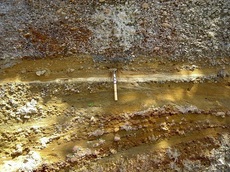Bulletin of the Geological Survey of Japan Top Page
Bulletin of the Geological Survey of Japan Vol.64 No.9/10 (2013)
Cover photograph | Table of Contents | Abstract
Cover photograph
 Fluvial deposits of the Middle Pleistocene Natsumi Formation in the Higashi-Ibaraki plateau
Fluvial deposits of the Middle Pleistocene Natsumi Formation in the Higashi-Ibaraki plateau
The middle white layer is a resedimented deposit of the Iiji-Moka tephra which was erupted from Iiji volcano in Yuzawa Town, Niigata Prefecture, at ca. 0.22 Ma and represents a time-marker for Marine Isotope Stage (MIS) 7c. This strata was previously called as “the middle part of the Miwa Formation”, but should be separated from the Miwa Formation deposited in MIS 5e. Kamiyama, Oarai Town, Ibaraki Prefecture.
(Photograph and Caption by Takahiro Yamamoto)
Table of Contents
All the pages PDF : 64_09_full.pdf [21.2MB]
| Title | Author | |
|---|---|---|
| Article | ||
| New stratigraphy for the Pleistocene system beneath the Higashi-Ibaraki plateau, NE Japan, and its relationship to the sea-level change in MIS 5-7: redefinition of the Ibaraki, Miwa, Natsumi and Kasagami Formations based on subsurface geology and correlation of tephra layers | Takahiro Yamamoto (225 − 249) |
64_09_01.pdf [10.9MB] |
| Quantitative re-description of tephra units since 0.3 Ma in the Tochigi-Ibaraki region, NE Japan | Takahiro Yamamoto (251 − 304) |
64_09_02.pdf [9.6MB] |
| Report | ||
| Radiometric Dating of tephras from Pre-caldera and Caldera- forming stages, Towada volcano, Northeast Japan | Takashi Kudo and Makoto Kobayashi (305 - 311) |
64_09_03.pdf [1.3MB] |
Abstract
New stratigraphy for the Pleistocene system beneath the Higashi-Ibaraki plateau, NE Japan, and its relationship to the sea-level change in MIS 5-7: redefinition of the Ibaraki, Miwa, Natsumi and Kasagami Formations based on subsurface geology and correlation of tephra layers
Takahiro Yamamoto
The Pleistocene strata beneath the Higashi-Ibaraki plateau were formed under the influence of glacioeustasy. They consist mainly of muddy estuarine deposits filling an incised valley and overlying shoreface sandy deposits, and were called as the “Miwa Formation” by previous studies. However, the “Miwa Formation” includes several glacioeustasy cycles and should be divided into new stratigraphic divisions. In this paper, I have examined lithofacies data of 46 boreholes along the Kasumigaura-Dosui tunnel and 19 ones along the Kita-Kanto and Higashi-Mito Highways, and recognize 6 incised-valley systems within the Pleistocene strata. Furthermore, I have measured the major element compositions of 9 tephra samples from outcrops of the Pleistocene strata and detected the 95-ka Kikai-Tozuhara, 0.13-Ma Akagi-Mizunuma 8, 0.22-Ma Iiji-Moka and 0.24-Ma Ata-Toihama tephras. As the result, I have redefined the Ibaraki, Miwa, Natsumi and Kasagami Formations, in descending order. These formations were deposited in Marine Isotope Stage 5c, 5e, 7a-c, and 7e, respectively.
Quantitative re-description of tephra units since 0.3 Ma in the Tochigi-Ibaraki region, NE Japan
Takahiro Yamamoto
Tephra units since 0.3 Ma in the Tochigi-Ibaraki region have been re-described with regard to their stratigraphy, compositions, ages and volumes, adding unpublished data. They were erupted from Takahara, Nantai, Akagi, Iiji and Haruna volcanoes. This study has listed up all tephra units, more than 0.1 km3 DRE in volume, from these volcanoes. The largest unit is the ca. 44-ka Akagi-Kanuma tephra (Ag-KP), whose minimum magma volume is 2 km3 DRE. Furthermore, this study has revised the tephrostratigraphy of the KR1 core in the central Tochigi by Kuwahara (2009), because his study included miscorrelations of some tephra units. New tephrostratigraphy is going to be a base of correlation for Quaternary strata and long-term evaluation for this region.
Radiometric Dating of tephras from Pre-caldera and Caldera- forming stages, Towada volcano, Northeast Japan
Takashi Kudo and Makoto Kobayashi
Towada volcano is an active volcano located in the northern part of the Northeast Japan arc. We carried out fission-track (FT) and AMS radiocarbon (14C) dating of tephras from Towada and Hakkoda volcanoes to establish a detailed eruptive history during the Pre-caldera and Caldera-forming stages of Towada volcano. The obtained FT ages were 0.23 ± 0.05 Ma for Shirobeta tephra (WP), 0.19 ± 0.05 Ma for T-6 tephra, 0.08 ± 0.03 Ma for Zarame 1 tephra (ZP1), and 0.09 ± 0.03 Ma for Okuse Pyroclastic Flow Deposits. Although these FT ages are consistent with stratigraphy, they have large error ranges of several tens of thousands of years. Therefore, further examinations including application of other chronological dating methods are necessary to obtain more precise estimates of the eruptive age of these tephras. The obtained 14C age was 17,730 ± 70 BP for Biscuit 2 tephra (BP2). Based on stratigraphical consistency, this 14C age is appropriate for the eruptive age of BP2.
Geological Survey of Japan, AIST
- About GSJ
- Our Activities
- Purchase guide
-
Publications and Database
- information
- Bulletin of the Geological Survey of Japan
- bull2025(Vol.76)
- bull2024(Vol.75)
- bull2023(Vol.74)
- bull2022(Vol.73)
- bull2021(Vol.72)
- bull2020(Vol.71)
- bull2019(Vol.70)
- bull2018(Vol.69)
- bull2017(Vol.68)
- bull2016(Vol.67)
- bull2015(Vol.66)
- bull2014(Vol.65)
- bull2013(Vol.64)
- bull2012(Vol.63)
- bull2011(Vol.62)
- bull2010(Vol.61)
- bull2009(Vol.60)
- bull2008(Vol.59)
- bull2007(Vol.58)
- bull2006(Vol.57)
- bull2005(Vol.56)
- bull2004(Vol.55)
- bull2003(Vol.54)
- bull2002(Vol.53)
- bull2001(Vol.52)
- Bulletin of the Geological Survey of Japan(old)
- Annual Report on Active Fault and Paleoearthquake Researches
- Reports, Geological Survey of Japan
- CCOP-GSJ Groundwater Project Report
- CCOP Technical Bulletin
- Cruise Report
- Geological Hazards
- Learning and Education
- GSJ Database Collection
- Collection of links

